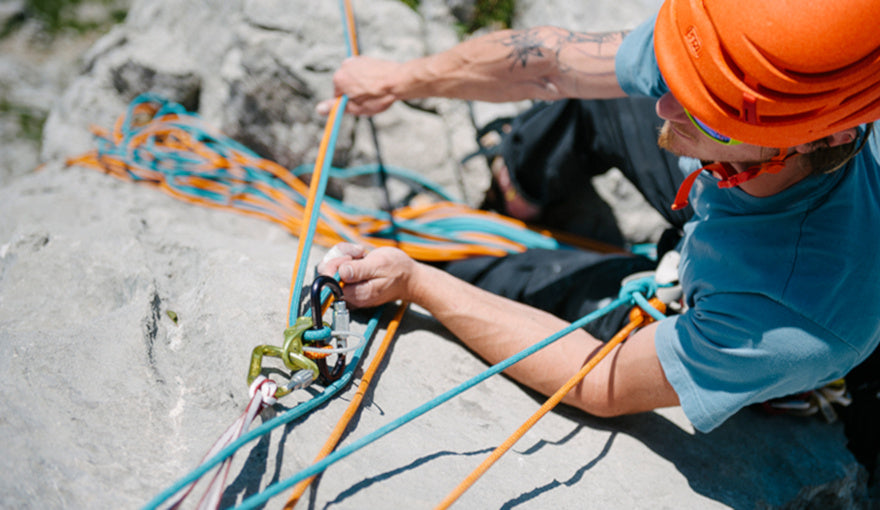By Jonathan Doyle
As the leader, when you reach the top of a climb, you need to secure the rope so you can safely belay your climbing partner. This can be done in a number of ways: the classic way involves attaching yourself to your anchor and then belaying your second with your belay device attached to your rope/belay loop; the second, often seen as the modern technique, is to use a guide-plate/assisted-locking device attached directly to your anchor.
A guide belay plate is similar to the traditional belay device many of us started with, only it is equipped with two additional metal loops to allow direct attachment to the anchor and to facilitate its assisted-locking capabilities.
We have made a quick video to highlight how easy it is to belay a climber from above using a belay plate in guide mode.
Pros
- In the event of a fall, the force is entirely directed through the anchor. Note: this point could also be a con on routes with less than perfect anchors - such as winter routes (ice screws) or routes with friable rock. Major teaching point is to only use guide-mode on 100% unquestionable anchors.
- It can be a much more comfortable system to use, especially if the second is hanging around on the rope for a while.
- If the belayer drops the rope or falls unconscious for any reason, the belay device will automatically lock the rope in the event of a fall.
- It is much easier for the belayer to escape the system in the event of an emergency.
- The leader can safely belay two climbers at once, maximising efficiency when climbing as a three.
Cons
- You need to buy a guide belay device and an additional locking carabiner.
- Slower to use when alternating leads as you have to re-adjust the belay device and attach it to your harness when you are belaying from below.
- It is quite a complicated system to lower a climber in the event of a fall.
Extra Tips
- It is a good idea to set up your anchor at a good height above your waist as if it is not, it can be fairly uncomfortable to belay while bent right over.
- If you are belaying two climbers, make sure the faster climber sets off first and a good few metres of space is given before the final climber begins. In addition, ensure the seconds do not cross their ropes. Finally, the seconds should make every effort to avoid weighting the rope. This is because if one of the climbers does rest, the belay device will lock and no further progress can be safely made by the other climber. This could lead to a big fall by the active climber if they do not notice the first resting.
- If you need to lower a climber with whom you are using guide mode, always ensure the rope is backed up with a prussic before any attempt is made to release tension in the system. Andy Kirkpatrick has written a good article about this on his blog.
- Always carry out your safety checks, making sure all screw gates are locked and every part of the system is secure.
Belay Guide Plate Round-up
There are a good number of belay devices which facilitate the use of guide mode; here is a quick round-up of our favourites, in no particular order.
| Cost (RRP) | Weight (g) | No. Of Ropes | Rope Diameter (mm) | |
| Edelrid Mega Jul | 30 | 88 | 1 or 2 | 7.8 - 10.5 |
| Black Diamond ATC Guide | 25 | 88 | 1 or 2 | 7.7 - 11 |
| DMM Pivot | 34 | 72 | 1 or 2 | 7.5 - 11 |
| Petzl Reverso | 28 | 59 | 1 or 2 | 7.5 - 11 |
| Petzl GriGri+ | 101 | 200 | 1 | 8.9 - 10.5 |
Whilst not a traditional guide mode belay device and also quite heavy, the Petzl GRIGRI + is by far the most versatile device and its assisted breaking works without any additional screwgate carabiners. It is also the quickest device when it comes to lowering a climber in guide mode as it is much easier to release the tension when the rope is locked. The best value for money is probably the Petzl Reverso 4, as while it is slightly more expensive than the Black Diamond ATC Guide, it is lighter and can also handle a greater range of rope thicknesses. The DMM Pivot would be a great choice if you’re budget is a little higher as the pivot system allows for easier rope control and it also has two friction modes. In conclusion, whichever belay guide plate you decide to buy, ensure you know exactly how to use it before you use it with a partner, as the last thing you want is to accidentally drop them! Climb safe, and of course if you are uncertain about anything discussed in this article, please seek professional guidance and training.















